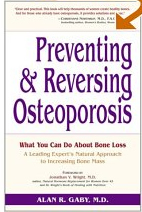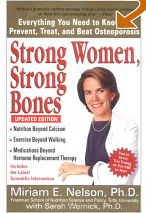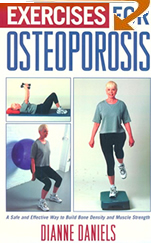Osteoporosis
Index of Diseases / Health Conditions ... Medicinal Foods, Herbs, Spices & Household Items
The below provides a general overview on this topic and may not apply to everyone. Any treatment protocol should be discussed with a qualified healthcare practitioner ... Please refer to: Medical & Legal Disclaimer.
 Ten million people in the U.S. (80% of them women) are said to have osteoporosis, and almost 34 million are at risk because of low bone mass. Surprisingly, the number of hip fractures is how much higher in the United States and Europe than in many undeveloped countries. But as countries in Asia and other areas are westernized, hip fracture rates are increasing, which seems to support the theory that this disease is diet and lifestyle related.
Ten million people in the U.S. (80% of them women) are said to have osteoporosis, and almost 34 million are at risk because of low bone mass. Surprisingly, the number of hip fractures is how much higher in the United States and Europe than in many undeveloped countries. But as countries in Asia and other areas are westernized, hip fracture rates are increasing, which seems to support the theory that this disease is diet and lifestyle related.
Bones are living organisms that, once they stop growing in size, undergo constant repair and maintenance. In our mid-30s (somewhat later in men), women start losing bone mass at the rate of 0.5 to 1 percent a year.
According to the National Osteoporosis Foundation, one in two women and one in four men over the age of 50 will have an osteoporosis-related fracture in their remaining lifetime.
Osteoporosis is responsible for 1.5 million fractures a year in the U.S.:
- 300,000 of the hip
- 700,000 of the vertebra
- 250,000 of the wrist
- 300,000 other.
According to the Mayo Clinic of Osteoporosis (Mayo Foundation, 2003):
- only a third of the people who break a hip return to being as active as they were before the fracture
- nearly another third wind up in a nursing home permanently
- A study in 2002 reported that as many as 20 percent of hip fracture patients die within a year of their injury.
 A number of lifestyle, medical, and dietary factors contribute to the loss of bone mass. The Osteoporosis Education Project, Women to Women urge women to eliminate those activities and foods that contribute to bone loss and encourage those that build bone. Also, please consider other contributing factors listed below:
A number of lifestyle, medical, and dietary factors contribute to the loss of bone mass. The Osteoporosis Education Project, Women to Women urge women to eliminate those activities and foods that contribute to bone loss and encourage those that build bone. Also, please consider other contributing factors listed below:
Surprising Causes:
- Smoking: HealthDay News reports that smoking can harm skeletal health, affecting our bones and joints. The American Academy of Orthopaedic Surgeons lists these musculoskeletal problems that can be triggered by smoking:
- Increased risk of osteoporosis.
- Decreased bone density.
- Reduced ability to absorb calcium.
- Reduced protection provided by estrogen replacement therapy.
- Increased risk of hip fracture as a person ages. Increased risk of developing an exercise-related injury.
- Magnesium Deficiency: According to the National Academy of Sciences, most Americans are magnesium deficient, which the academy says helps to account for high rates of heart disease, stroke, osteoporosis, arthritis and joint pain, digestive maladies, stress-related illnesses, chronic fatigue and a number of other ailments.
- Cadmium Poisoning: Farmed shellfish is frequently contaminated with cadmium which is extremely toxic even in low concentrations. Ingestion of any significant amount of cadmium causes immediate poisoning and damage to the liver and the kidneys. The bones become soft (osteomalacia), lose bone mass and become weaker (osteoporosis).
- Untreated Celiac Disease (CD) can lead to diabetes, osteoporosis and even cancer.
Things you can do to prevent boneloss / build healthy bones
- General Lifestyle: Quit smoking, drink in moderation
- Caffeine: According to osteoporosis expert Robert Heaney of Creighton University in Omaha, you lose up to 5 milligrams of calcium for every six ounces of regular coffee (or two cans of cola) you drink. As little as 300 to 400 mg of caffeine a day doubles the risk of hip fracture. He suggests offsetting the loss by adding one or two tablespoons of milk to your coffee. Note: caffeine is also in black or green tea, as well as chocolate.
 Reduce the stress in your life (or practice meditation or yoga)
Reduce the stress in your life (or practice meditation or yoga)- Diet:
- Reduce the amount of acid-forming foods, such as meat, dairy, sugars, and most grains, in your diet.
- Increase the amount of fresh fruits and vegetables. Excellent food choices are:
- Kale, broccoli and white beans. Milk and other dairy products, such as yogurt and cheese, are good sources of calcium, but these three non-dairy sources can also help you meet your daily requirements
- Shiitake mushrooms. Calcium is ineffective without vitamin D. While the sun is the primary source of vitamin D, there are food sources as well. Shiitake mushrooms, for example, or canned sardines and wild salmon (no bones are needed for vitamin D, but include the bones and you'll get a two-in-one bonus for both calcium and vitamin D), shrimp, egg yolks and vitamin D-fortified whole grain cereals or soy milk.
- Supplement:
- The Osteoporosis Educational Project recommends 19 key nutrients. The most important turns out to be vitamin D, not calcium. The Nurses Health Study, which followed 72,000 women over 25 years, found that women who drank milk twice a day were as likely to suffer a fracture as those who drank it once a week. The Health Professional Follow-up Study also failed to find a link between calcium intake and fractures, and a Swedish study of more than 60,000 women produced the same results. However, there is one rather strong relationship: The countries with the highest level of dairy consumption, like the US and Sweden, have the lowest bone density measures and the highest rates of hip fractures.
- Vitamin D is incredibly important, and best-selling formulas don't give you near enough. Women with osteoporosis are often instructed by their doctors to get up to 1,200 milligrams (mg.) every day. However, natural sunlight or full-spectrum indoor lighting may help you produce Vitamin D naturally (without supplementation).
- Cod liver oil is most famous for contributing to bone health, preventing and reversing rickets in children and osteomalacia in adults.16, 17 Before the discovery of cod liver oil as a source of vitamin D, many children suffered greatly with deformed bones. Osteoporosis responds to vitamin D and to cod liver oil. Sufficient elongated omega-3 oils found in cod liver oil are one of the keys to keeping and rebuilding bone. In women, higher levels of vitamin D from cod liver oil improve bone mineral density.
- Calcium: The recommended dose often is 1,000 - 1,500 mg a day (take at least 2 hours before or after any osteoporosis medication). However, supplementing with over 800 mg a day or using a carbonate-based supplement appears to have a drying, muscle-contracting effect on the intestines resulting in constipation. For this reason, if these symptoms occur, it's best to switch to calcium citrate. It's easier on the gut and better absorbed by the body. Alternatively, pair calcium with magnesium. In addition to boosting calcium absorption by ~70%, magnesium has muscle-relaxing properties that cancel out calcium's intestine-contracting effect. (You can purchase it as one convenient supplement: NOW Calcium & Magnesium at local drug stores. Or ask for a recommendation at your local health food store).
- Natural calcium is found in dairy foods, canned salmon (with bones), sardines, dark-green and leafy vegetables, almongs, asparagus, figs
 Strontium supplements were found to increase bone density in a recent clinical trial.
Strontium supplements were found to increase bone density in a recent clinical trial.- Silicon is a trace mineral that's essential for bone formation.
- Vitamin C is required for the production of collagen, a component of bone tissue.
- Vitamin K helps calcium bind to bone tissue.
- Enzymes are responsible for metabolism, which is our cells directing each nutrient to combine and interact with other nutrients to crate other chemicals and compounds to build and repair our cells, bones, tissues and organs.
- The Osteoporosis Educational Project recommends 19 key nutrients. The most important turns out to be vitamin D, not calcium. The Nurses Health Study, which followed 72,000 women over 25 years, found that women who drank milk twice a day were as likely to suffer a fracture as those who drank it once a week. The Health Professional Follow-up Study also failed to find a link between calcium intake and fractures, and a Swedish study of more than 60,000 women produced the same results. However, there is one rather strong relationship: The countries with the highest level of dairy consumption, like the US and Sweden, have the lowest bone density measures and the highest rates of hip fractures.
- Exercise. Commit to a weight-bearing exercise routine for an hour two to three times a week. This can significantly slow or prevent bone loss.
- Countering the effects of prescription drugs and endocrine disorders requires working with your healthcare provider to find alternatives and root causes.
Information contained on this website is provided as general reference only. For application to specific circumstances, professional advice should be sought.
GreenAndHealthy.Info strives to maintain accurate and up-to-date information; however, mistakes do happen. If you would like to correct or update any of the information, please send us an e-mail. THANK YOU!

